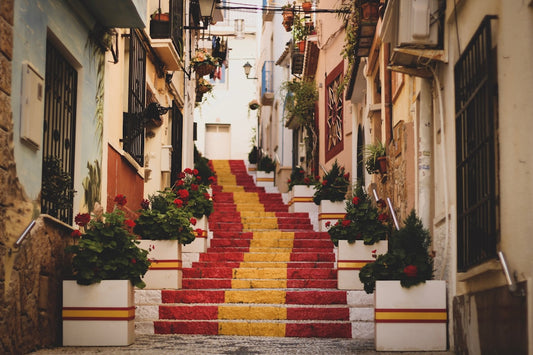You're about to embark on a journey to a vibrant country that seamlessly blends ancient traditions with modern innovations. Spain, a nation rich in history and culture, is a treasure trove of fascinating stories and customs that will leave you intrigued.
As the second most visited country in the world after France, Spain's allure is undeniable. From breathtaking beaches to historical cities, and from flamenco to tapas, there's no shortage of exciting experiences to be had.
As you explore this captivating world of Spanish culture, you'll discover a diverse array of regional identities, each contributing their unique flavor to the nation's heritage. Get ready to uncover the hidden gems that make Spain a standout destination.
Spain's Rich Cultural Heritage
As you explore Spain, you'll discover a nation where cultural heritage is deeply intertwined with its history, language, and national identity. Spain's cultural landscape is a testament to its complex past, with various influences shaping its present.
The Country of Multiple Languages
Spain is home to multiple languages, with Spanish being the official language at the national level. However, several regions have their own co-official languages, such as Catalan in Catalonia, Basque in the Basque Country, and Galician in Galicia. This linguistic diversity is a reflection of the country's rich cultural heritage and regional identities.
The presence of multiple languages has not only contributed to the cultural richness of Spain but has also played a significant role in shaping its national identity. Efforts to preserve and promote these languages are evident in regional governments' policies and educational systems.
Spanish Influence on Global Communication
Spanish is one of the world's most widely spoken languages, with a significant presence in global communication. It is an official language in several international organizations, including the United Nations and the European Union. The influence of Spanish extends beyond Spain's borders, with many countries in Central and South America, as well as the United States, having Spanish as an official or widely spoken language.
The global reach of Spanish has facilitated cultural exchange and has positioned Spain as a significant cultural influencer worldwide. This is evident in the country's thriving film industry, literature, and arts, which enjoy international recognition.
A Wordless National Anthem
Spain's national anthem, "La Marcha Real" (The Royal March), is one of the few national anthems in the world without official lyrics. The anthem has a long history, dating back to the 18th century, and was officially adopted in 1770.
Despite several attempts to add lyrics throughout its history, none have been permanently adopted. The reasons behind this are largely rooted in the country's political and cultural divisions, which have made it challenging to agree on universally acceptable lyrics.
Interestingly, the absence of lyrics has not diminished the anthem's significance or its role as a unifying element. At official events, sporting competitions, and national celebrations, "La Marcha Real" is performed with great pride, symbolizing national unity and identity.
| Aspect | Description |
|---|---|
| Name of the Anthem | "La Marcha Real" (The Royal March) |
| History | Dating back to the 18th century, officially adopted in 1770 |
| Lyrics | No official lyrics |
| Significance | Symbolizes national unity and identity |
Comparatively, Spain is not alone in having a wordless or partially wordless national anthem. Countries like Bosnia and Herzegovina, and Kosovo, also have anthems without lyrics, highlighting the complexity of representing national identity through music alone.
- The history of "La Marcha Real" reflects the country's complex past and its evolution over time.
- The absence of lyrics has allowed the anthem to serve as a unifying element across diverse regional identities.
- The performance of the anthem at various events underscores its importance in Spanish culture and national identity.
Fascinating Fun Facts About Spain's Geography

As you explore Spain, you'll discover a land of contrasts, where mountains meet the sea and islands boast unique ecosystems. Spain's geography is a treasure trove of fascinating facts, waiting to be uncovered.
A Land of Mountains and Islands
Spain is home to some of Europe's most impressive mountain ranges, including the Pyrenees and the Sierra Nevada. The country's varied landscapes are not limited to its mainland; the Canary Islands, for instance, offer a unique blend of volcanic landscapes and subtropical climates. The Canary Islands were formed by volcanic eruptions and have a subtropical climate, but they're by no means the same. Each of the seven main islands (Tenerife, Fuerteventura, Gran Canaria, Lanzarote, La Palma, La Gomera, and El Hierro) has its own unique weather patterns and ecosystems.
The Impressive Spanish Coastline
Spain's coastline stretches over 4,964 kilometers, offering a diverse range of beaches, bays, and cliffs. The country's coastal regions are not only beautiful but also play a significant role in its economy, with many areas dedicated to tourism and fishing. The varied coastline contributes to the country's appeal, making it a popular destination for travelers from around the world.
Unique Climate Characteristics
Spain's diverse geography creates multiple climate zones, from the rainy north to the arid central plateau and the Mediterranean south. This diversity in climate contributes to Spain having the second-highest average life expectancy in the world at 82.4 years. The favorable climate also makes Spain a leader in renewable energy, particularly wind and solar power.
| Region | Climate | Characteristics |
|---|---|---|
| North | Rainy | Green landscapes, significant rainfall |
| Central Plateau | Arid | Dry conditions, extreme temperatures |
| Mediterranean South | Mediterranean | Mild winters, warm summers |
The climate diversity allows for year-round tourism, with skiing in the mountains and beach activities on the coast. However, Spain also faces environmental challenges due to climate change, including desertification in some regions. Understanding and appreciating Spain's geography can help you make the most of your visit, whether you're interested in exploring its natural beauty or experiencing its rich cultural heritage.
Spain's Culinary Wonders and Traditions
From the sun-kissed olive groves to the vineyards of Rioja, Spain's culinary wonders are a testament to its rich gastronomic heritage. As you delve into the world of Spanish cuisine, you'll discover a blend of tradition, culture, and passion that makes every meal a memorable experience.
Home to the World's Oldest Restaurant
Spain boasts the world's oldest restaurant, Botín, which has been serving customers since 1725. This historic eatery is a must-visit destination for anyone interested in experiencing the authentic flavors of Spanish cuisine. Its longevity is a testament to the country's enduring culinary traditions.
The Origin of Tapas
Tapas, those delightful small plates of food, have a rich history that is deeply intertwined with Spanish culture. The tradition of serving tapas is believed to have originated in Andalusia, where bartenders would cover drinks with a piece of bread or a small snack to keep flies out of the glass. Over time, this practice evolved into the diverse array of tapas that are now a hallmark of Spanish dining. You can enjoy a wide variety of tapas, from simple snacks like olives and cheese to more complex dishes like patatas bravas or gambas al ajillo.
Olive Oil Dominance
Spain is renowned for its high-quality olive oil, which is a staple ingredient in Spanish cooking. The country's olive groves, particularly in regions like Andalusia, produce some of the world's best olive oil. The use of olive oil is not just about flavor; it's also deeply rooted in Spanish culture and is a key component of the Mediterranean diet. You can experience the richness of Spanish olive oil by incorporating it into your cooking or by visiting olive oil mills and tasting the different varieties.
The Wine Culture
With its vast number of vineyards and status as the third-largest wine producer in the world, Spain is a renowned destination for wine enthusiasts. From the famous Rioja to sparkling Cava, each region in Spain offers unique grape varieties that contribute to their distinct flavor profiles. You can explore the diverse wine regions, such as Ribera del Duero for red wines, Rías Baixas for whites, and Catalonia for Cava. The Bodega Irache Winery along the Camino de Santiago pilgrimage route is particularly noteworthy, featuring a free wine fountain that has been a tradition since 1891. This allows pilgrims and visitors alike to enjoy a refreshing taste of wine throughout their journey.
- Spain's winemaking tradition dates back thousands of years, with the country producing a wide range of wines that cater to different tastes and preferences.
- The diverse wine regions of Spain offer a variety of grape varieties, including Tempranillo, Garnacha, Albariño, and Verdejo, each contributing to the unique character of Spanish wines.
- Wine plays a significant role in Spanish daily life, from casual meals to celebrations, and is an integral part of the country's culture.
- The economic importance of wine production and wine tourism in Spain cannot be overstated, as it contributes significantly to the country's economy and promotes cultural exchange.
Spanish winemaking is a balance of traditional methods and modern innovations, ensuring that the wines are not only of high quality but also reflective of the country's rich heritage. As you explore Spain's culinary wonders, you'll find that wine is an essential part of the gastronomic experience, complementing the local cuisine and enhancing the overall dining experience.
Unique Spanish Festivals and Traditions

You might be familiar with some of Spain's most famous festivals, but there's more to the country's traditions than meets the eye. Spain is a country that wears its culture on its sleeve, celebrating numerous festivals and observing time-honored traditions that are deeply ingrained in daily life.
La Tomatina: The World's Largest Food Fight
One of Spain's most iconic festivals is La Tomatina, a massive food fight held in Buñol where participants throw tons of tomatoes at each other. This event attracts visitors from around the world and is a testament to the Spanish spirit of fun and revelry.
The Running of the Bulls
Another famous Spanish tradition is the Running of the Bulls, held in Pamplona during the San Fermín festival. This event, made famous by Ernest Hemingway, involves participants running through the streets alongside bulls, showcasing bravery and agility.
Twelve Grapes at Midnight
On New Year's Eve, Spaniards celebrate by eating twelve grapes at midnight, one for each stroke of the clock. This tradition is believed to bring good luck for the coming year.
The Afternoon Siesta
The siesta is a deeply rooted tradition in Spanish culture, originating as a way to escape the afternoon heat. The word "siesta" comes from the Latin "sexta hora," meaning "sixth hour," referring to the time of day when people would rest.
The afternoon nap is more than just a rest; it embodies the Spanish approach to life, emphasizing a relaxed pace and time for rest. Traditionally, the siesta takes place from roughly 2:00 to 5:00 PM, affecting daily schedules with later dinner times and extended evening activities.
- The siesta reflects Spanish values regarding work-life balance, prioritizing quality of life over relentless productivity.
- In smaller towns and during summer months, some businesses still observe siesta hours, closing temporarily in the afternoon.
- While modern urban life has reduced the practice of siestas among working adults, the tradition remains an important part of Spanish cultural identity.
Unlimited Data eSIM from RAPIDeSIM
The eSIM Spain solution is becoming increasingly popular for travelers thanks to its simplicity and fast activation. Instead of inserting a physical SIM card, you can activate your plan instantly by scanning a QR code. It's compatible with most newer smartphones including iPhone 13 and up, as well as recent Samsung Galaxy models.
You can check if your device supports eSIM via our Compatibility Checker.
Why choose an eSIM for Mexico?
- Instant activation without visiting a store
- No need to remove your current SIM
- Flexible prepaid data plans tailored for tourists
- Strong 4G/5G coverage in major cities and tourist areas
- No roaming charges or unexpected fees
Get 5% OFF With Code: INTERNETEVERYWHERE25
Spain's Impressive Historical and Cultural Achievements
As you explore Spain, you'll discover a wealth of historical and cultural accomplishments that have shaped the nation. For centuries, Spain has been a melting pot of different cultures, resulting in a rich cultural heritage that continues to captivate visitors from around the world.
UNESCO World Heritage Sites
Spain is home to numerous UNESCO World Heritage Sites, reflecting its diverse cultural and historical significance. Many of these sites are architectural marvels, showcasing the country's rich history and cultural diversity. You can explore these sites in various parts of the country, from the historic centers of cities like Toledo and Segovia to the Alhambra in Granada.
La Sagrada Familia's Century-Long Construction
One of Spain's most iconic landmarks is La Sagrada Familia, Antoni Gaudí's masterpiece in Barcelona. The construction of this breathtaking cathedral has spanned over a century, with work beginning in 1882 and still ongoing. La Sagrada Familia is a testament to Gaudí's innovative architectural style and the dedication of the craftsmen who have worked on it over the years.
The First Modern Novel
Spain has a rich literary history, and one of its most significant contributions to world literature is "Don Quixote," considered the first modern novel. Written by Miguel de Cervantes and published in 1605, "Don Quixote" has had a profound impact on literature and continues to be celebrated as a masterpiece of Spanish culture.
The Moorish Influence
The Moors, a group of North African and Arabian Muslims, ruled parts of Spain for nearly 800 years, leaving an indelible mark on Spanish culture. Their influence can still be seen in the architecture, cuisine, and language of southern Spain, particularly in cities like Granada, Córdoba, and Seville. The Moors introduced new ingredients like rice, citrus fruits, almonds, and spices, transforming Spanish cuisine. Many Spanish words also have Arabic origins, reflecting the linguistic impact of the Moorish period.
The architectural legacy of the Moors includes magnificent structures like the Alhambra in Granada, the Mezquita in Córdoba, and the Giralda in Seville. These landmarks are not only testaments to the engineering and artistic skills of the Moors but also continue to attract visitors to these cities, contributing to the local economy and cultural heritage.
The cultural fusion resulting from the Moorish period has contributed significantly to Spain's unique identity, positioning it at the crossroads of European and Islamic civilizations. This multicultural heritage continues to be a significant part of Spain's appeal, drawing visitors to its southern regions, particularly Andalusia.
Surprising Facts That Make Spain Unique
You might know Spain for its beautiful beaches and rich history, but there are many more fascinating facts to discover. Spain's uniqueness is not just about its cultural heritage or geographical features; it's also about the everyday aspects that make it stand out.
A Country with an Unmatched Dining Culture
Spain is renowned for its culinary delights, and one of the most striking aspects is its high number of restaurants and bars. With approximately 260,000 bars throughout the country, you're never far from a spot to enjoy tapas or a café con leche. This dense concentration of dining establishments reflects the importance of food and social dining in Spanish culture.
An average Spanish town typically features numerous bars and restaurants on nearly every corner. These establishments serve everything from simple tapas to elaborate meals, catering to a wide range of tastes and preferences. The variety is not just in the food but also in the functions these places serve throughout the day, from morning coffee spots to late-night social hubs.
Economic and Social Importance of Dining Establishments
The restaurant industry in Spain is not just a significant contributor to the economy; it's also a major employer. The abundance of dining options contributes to Spain's vibrant street life and public socialization. Moreover, the variety of restaurants reflects Spain's regional diversity, with each area offering its own culinary specialties.
| Aspect | Description | Impact |
|---|---|---|
| Number of Bars and Restaurants | Approximately 260,000 bars across the country | High concentration of dining options |
| Cultural Significance | Reflects the importance of food and social dining | Vibrant street life and public socialization |
| Economic Contribution | Significant employer and contributor to the economy | Supports local economies and workforce |
More Surprising Facts
Besides its dining culture, Spain has other unique aspects. For instance, it's home to the world's oldest restaurant, according to the Guinness World Records. The Botín restaurant in Madrid has been serving customers since 1725, making it a must-visit for anyone interested in culinary history.
Spain's love for football is another aspect that makes it stand out. The country is home to some of the world's most renowned football clubs, and the sport is deeply ingrained in Spanish culture.
Additionally, Spain has an unusual time zone, considering its geographical location. This is a historical legacy that still influences the country's daily routines and schedules.
Conclusion
Through the lens of fun facts, Spain emerges as a captivating destination that masterfully balances tradition with innovation. As we've explored the diverse range of fascinating facts about Spain, from its multilingual heritage to its culinary innovations, it's clear that this country is a treasure trove of intriguing experiences.
These facts reveal Spain's unique character as a country of contrasts, blending ancient traditions with modern innovations. Understanding these interesting facts about Spain enhances appreciation for its contributions to global culture, language, cuisine, and art. The rich tapestry of history, culture, and innovation makes Spain one of the world's most captivating destinations.
Spain continues to evolve while maintaining its distinctive cultural identity and traditions. We encourage you to discover more about Spain through travel, further reading, or exploring Spanish culture in your own communities. Share your own facts about Spain or experiences in the country, as there's always more to uncover about this incredible nation.
In conclusion, Spain's blend of rich heritage and modern appeal makes it a Spain best destination for travelers and culture enthusiasts alike. With its numerous facts and fascinating history, Spain is sure to captivate anyone who explores it.








